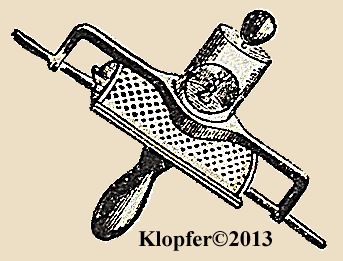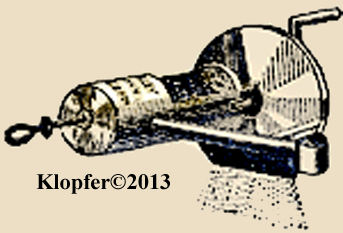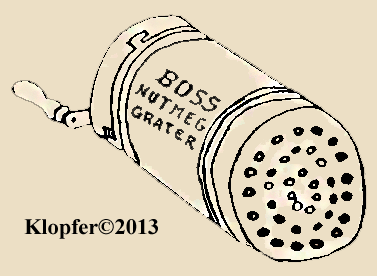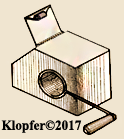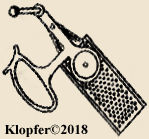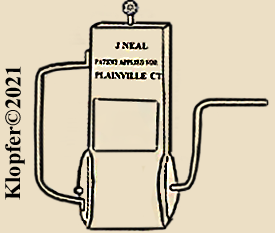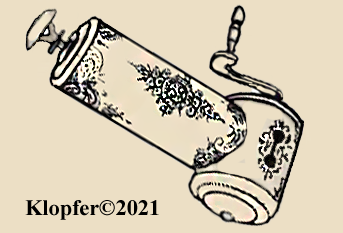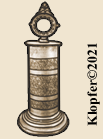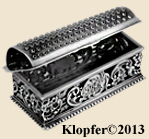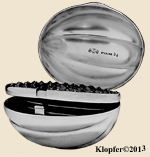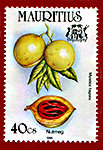 Click Me!
Click Me!
NutmegGraters.Com

- Home
- Featured Stories
- Picture Gallery
- Info.Wanted :
- Spurious Marks
- Trading Post
- Contact Our Site
- Wanted To Buy
[WELCOME: My articles published on NutmegGraters.Com and commercially (elsewhere) required many years of primary research, personal expense, travel and much effort to publish. This is provided for your enjoyment, it is required that if quoting my copyrighted text material, directly provide professionally appropriate references to me. Images are unavailable for copy. Thank you J. Klopfer.]
_______________________________________________________________________________________________________________________________________________________
The J. Neil Nutmeg Grater ~ Hiram Carsley, Inventor ;
And Its Redesign In Silver By Theodarus Lambertus Uriot
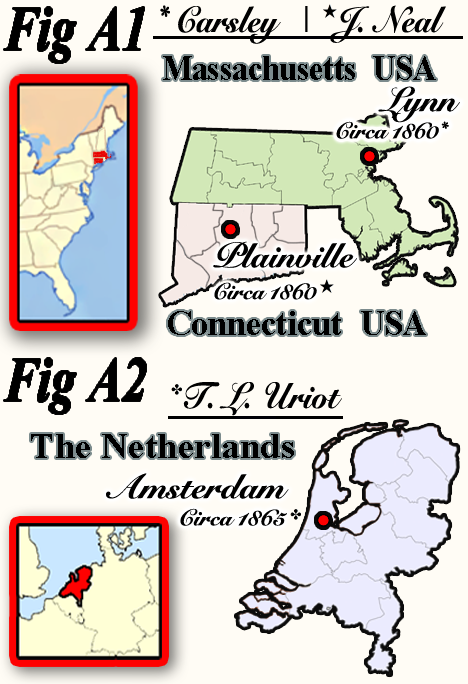 While many nutmeg grater designs never leave the drawing board, other designs go into production, sometimes resold and produced through a series of different manufacturers. The J. Neal Nutmeg Grater of Plainville, Connecticut (USA) originated in Lynn Massachusetts (USA) (Figs A1). Later, the design was elegantly recreated by a skillful silversmith in Amsterdam, Holland (Figs A2). By comparing the embossed labeling and maker's marks observed among these various nutmeg graters, a detailed product history is discovered.
While many nutmeg grater designs never leave the drawing board, other designs go into production, sometimes resold and produced through a series of different manufacturers. The J. Neal Nutmeg Grater of Plainville, Connecticut (USA) originated in Lynn Massachusetts (USA) (Figs A1). Later, the design was elegantly recreated by a skillful silversmith in Amsterdam, Holland (Figs A2). By comparing the embossed labeling and maker's marks observed among these various nutmeg graters, a detailed product history is discovered.
An American invention of the mid-nineteenth century, mechanical nutmeg graters originated from Ward 6, Lynn, Massachusetts near the "Lynn Common" train station (Fig E3). In Lynn, about 1852, the first mechanical nutmeg grater was invented (but never patented) by Edmund Brown (1804~1858). Seeing Brown's great success, neighboring competitor tinsmiths and metal workers quickly developed there own improved prototypes for sale. Patented in 1855, Hiram Carsley (1820~1901) improved Brown's Rotary Nutmeg Grater, and likely worked for Edmund Brown (See Opposite: Hiram Carsley's Rotary Nutmeg Grater © September 2013). An identical feature found in common between both of their products, the "grate" was created using the very same punch device to form the "flat-circular disk" grating wheel used within both nutmeg graters. This punch device resulted in identical, unevenly arranged rows of "teeth" (A.K.A.: perforated grating holes.). This proves that Carsley's "patented 1855" nutmeg grater is a transitional improvement to Brown's earlier nutmeg grater. Most of Carsley's nutmeg graters are incused-punched with the label (as shown below): "H. Carsley ~ Patented Nov 20 1855 ~ Lynn Mass" to include an asterisk-like central-decoration (Fig B). Indicating a business connection between these men, Carsley's US Patent # 13834 assigns half ownership rights with his nutmeg grater to Brown (usually an indication that Brown {as assignor} provided financial backing for Carsley's product and that they are joined together within a business venture.)
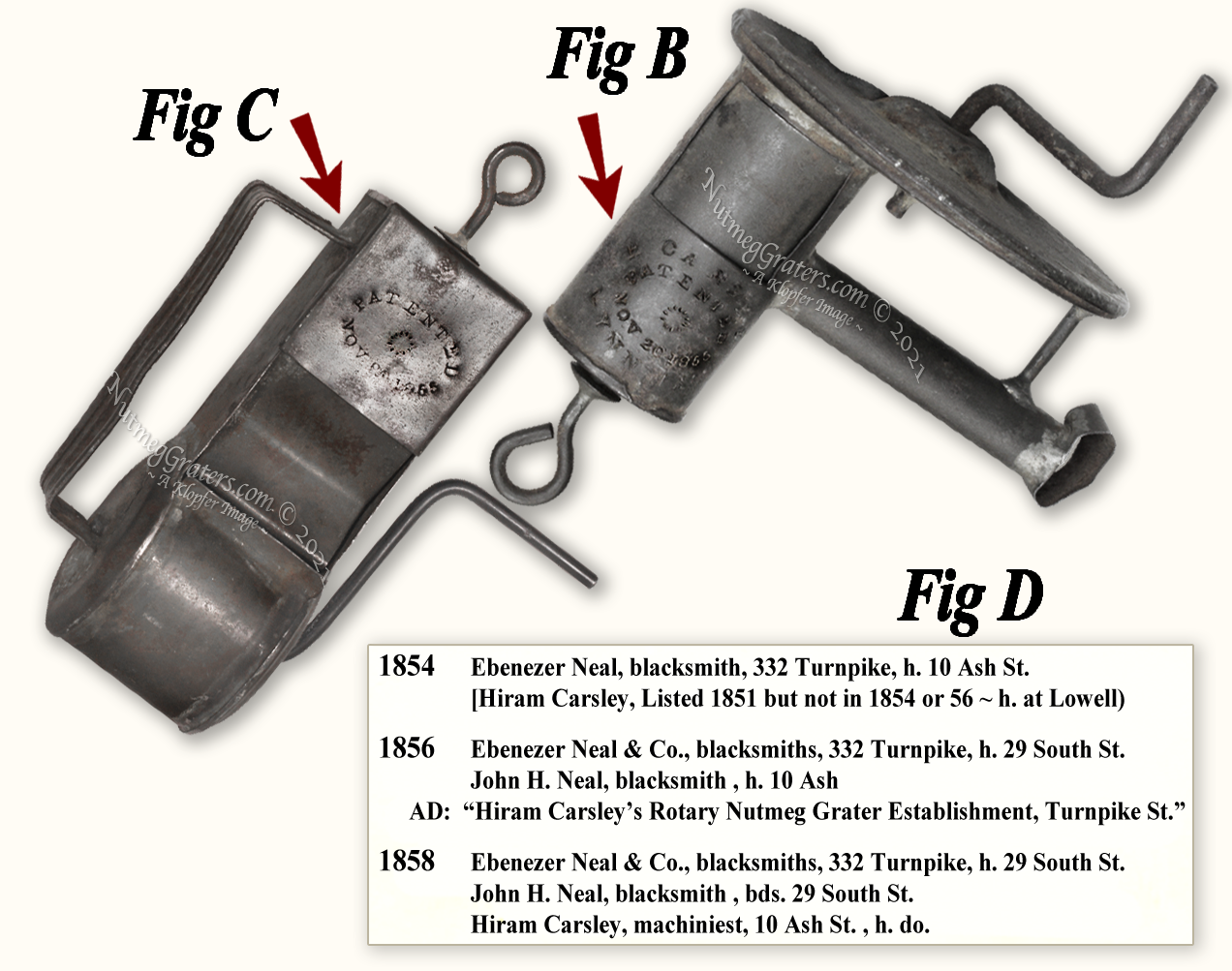
The New Design:
An advancement from Carsley's original patented model (Fig B) was the creation of this new transitional model (Fig C). Linking these two nutmeg graters, notice that they each bear the identically embossed maker's marks: "PATENTED" and "NOV. 20, 1955", to include the asterisk-like central-decoration. Being marked by the same punch tool indicates that both nutmeg graters have connection with a single, in common source.
Although the overall appearance may seem different, there are several common features confirming that the newer model was developed as an improvement to the earlier design. Notice the likenesses with both examples:
1). the plungers and crank handles are of the same gauged wire; 2). each plunger handle bears an identical "stopper-collar" restricting the plunger from pressing back against the grating surface; and 3). each plunger handle terminates in an identical shepherd's hook looped finger-pull.
 And then there are the improved components:
And then there are the improved components:
1). The "grate" is changed from its original flat rotating-disk construction, replaced by a rotating cylinder-grate; 2). the nutmeg is still pressed against its grating surface under spring tension, but the earlier is housed within an tubular enclosed chamber, while the shape with the new version is square; and 3). the improved version is constructed using few pieces that are simpler to assemble.
So Who Is "J. Neal"?
The two earlier products (Fig B & C) were embossed using the same central punch tool (F1), but oddly, the newer product bares neither the "H. Carsley" name nor the "Lynn, Mass" location. Adding more confusion, later examples of this newly improved design completely eliminate the words "PATENTED" and "NOV. 20, 1955", replacing them with the marks: "PATENT APPLIED FOR" (F2), and then,
"J. NEAL ~ PATENT APPLIED FOR ~ PLAINVILLE CT" (F3). So, who is "J. Neal"? And, where was this new transitional nutmeg grater actually made?
Using a variety of public records (census, city directories, vital statistics, etc), NutmegGraters.Com conducted an in-depth and definitive genealogical study of the Neal families associated with Lynn, Massachusetts and with Plainville, Connecticut. From this study, it was observed that a long-line of Neal family descendants worked throughout the iron, tinplate and metals industries. Tracing these families backwards through three generations, the study failed to find a direct lineage between the Neal family of Lynn and the Neal family of Plainville {requiring more study to definitively exclude any broader or less direct family links}. While the Lynn branch came from Maine, the Plainville branch descended from New Haven, Connecticut. The study also identified an additional complication in that some candidates copy.png) were known to use multiple spelling variations ~ "O'Neal, Neall, Neal, Nealle" and "Neale", being a possible conflict to exclude individuals because their name does not always "exactly match" to the J. Neal maker's mark spelling. Stemming from this study, this investigation found four possible candidates (one in Lynn; three in Plainville):
were known to use multiple spelling variations ~ "O'Neal, Neall, Neal, Nealle" and "Neale", being a possible conflict to exclude individuals because their name does not always "exactly match" to the J. Neal maker's mark spelling. Stemming from this study, this investigation found four possible candidates (one in Lynn; three in Plainville):
A. John H. Neal of Lynn, Massachusetts:
By 1851, it is known that Hiram Carsley worked near the Lynn Common Depot (E3), and that, this is where his life intertwined with the Neal family. Born in North Berwick, Maine, Ebenezer Neal (1797 ~ ) established his blacksmith shop before 1830, near Turnpike and South Streets in Lynn, where he met and married his wife Prissilla. His second son John H. Neal (1833~1888), along with the entire family, certainly had direct ties with Hiram [See: Lynn City Directory Excerpts (Fig D) ]. Notice that about 1856, Ebenezer transferred his 10 Ash Street home to his son John H. (age 23), then, relocated only a few houses away to 29 South Street (E1 & E2). Also during this time, Ebenezer Neal & Co. was established, where Ebenezer's eldest son Charles became his partner.
In 1855, the Hiram Carsley's Rotary Nutmeg Grater Establishment had opened (E4) in this same vicinity, being three doors down from the train station, but this location was short-lived. By 1858, the Neals sold the 10 Ash Street property to Hiram Carsley, where he relocated both his residence and the Rotary Nutmeg Grater Establishment. Of coincidence, Carsley's "co-assignor Edmund Brown" died in 1858, about when Hiram bought the 10 Ash Street property, leaving total control over the nutmeg grater to Carsley.
This all raises many unanswered questions. Could John H. Neal be the person indicated as "J. Neal" on the nutmeg grater? Hiram acquired the home where John H. was living. The earliest graters (Fig B & C) bear the same central punch tool connecting both of these products ~ so, is it conceivable that John H. redesigned Carsley's product? The Neals and Carsleys remained near neighbors for many decades. John H. remained single, never marrying 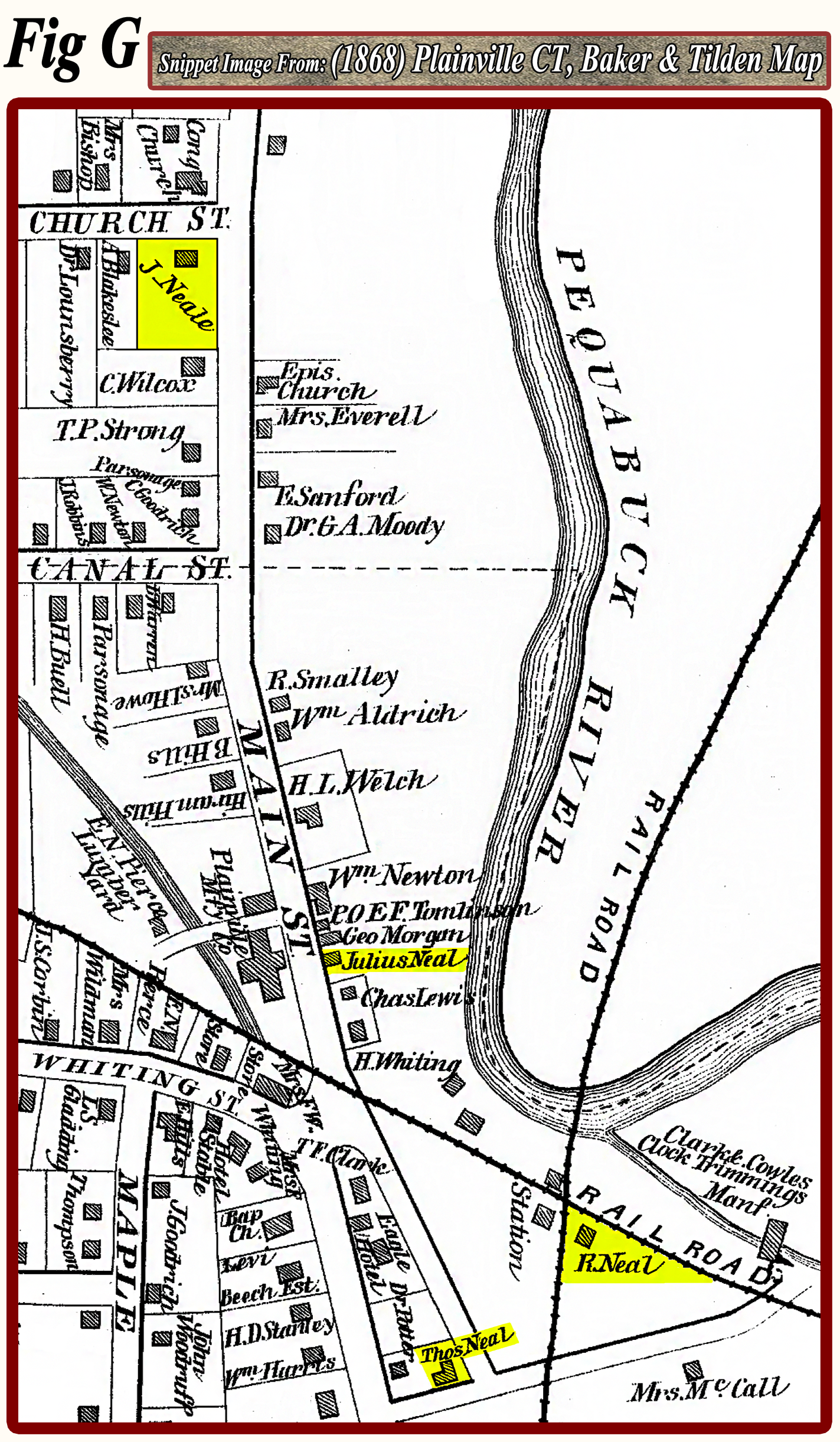 throughout his life. He always worked as a blacksmith (most often listed with his father's business), and the evidence is strong that John H. never lived away from Lynn, never residing in "Plainville, CT". Throughout every record (census, city directories, military records, head stones, death and birth records, cemetery records, etc.,) "John H." is consistently referenced using his middle initial, giving an appearance that his was a common name and the "H." distinguished him from the others. Based on this, if the nutmeg grater is the product by John H. Neal, than way isn't it marked J. H. Neal? Although there is no evidence, one of the Neal family members might have redesigned the "Carsley Patented Model" and was the connection to the Neal family in Plainville... but this is only one possible theory, suggested without evidence.
throughout his life. He always worked as a blacksmith (most often listed with his father's business), and the evidence is strong that John H. never lived away from Lynn, never residing in "Plainville, CT". Throughout every record (census, city directories, military records, head stones, death and birth records, cemetery records, etc.,) "John H." is consistently referenced using his middle initial, giving an appearance that his was a common name and the "H." distinguished him from the others. Based on this, if the nutmeg grater is the product by John H. Neal, than way isn't it marked J. H. Neal? Although there is no evidence, one of the Neal family members might have redesigned the "Carsley Patented Model" and was the connection to the Neal family in Plainville... but this is only one possible theory, suggested without evidence.
B. James Neal of Plainville, Connecticut:
In the 1860 census, James (1822~1900) and his wife Charlott resided on the road from South Washington Street to Red Stone Hill,1 in Plainville, where they lived with 7 children [based on ages, some of these children may have been siblings]. Born in England, the couple emigrated to the United States in the early 1850's, first residing somewhere in Massachusetts, before moving to Connecticut. James was farmer owning 60 acres of land in Plainville, but who also worked in additional jobs [as "cuff knitter" and "Works in a Hame Shop"~ possibly at Hill's Hame Shop {"Hames": a vital part of a work-horse's harness}]. Little more is currently known pertaining to James Neal and as yet, there seems no connection to the manufacturing or marketing of the "J. Neal" nutmeg grater.
C. Jeremiah Neale (Neal) of Plainville, Connecticut:
Jeremiah Neale (1802~1890) was born in Southington, Connecticut, the son of Jeremiah Neal (1757~1827) and Anna {Fuller} (1760~1823). He was one of 10+ siblings, (oddly each sibling selected different name spellings to use throughout their lives: "Neal, Neale, Nealle"). In Southington, the extended Neal family owned many very successful manufacturing ventures in iron, tin and other metals; and Jeremiah became a very successful metals manufacturer (iron bolts). After two new railroads were built through Plainville {the New Haven and Northampton railroad in 1848 and the Boston, Erie and New England railroad in 1850), venture capitalist were attracted to Plainville. Early in the 1850's, Jeremiah removed from Southington, Connecticut to Plainville, where he began listing his occupation as "Gentleman" {a Gentleman is someone who does not work at an occupation, but instead, lives from his investments}. His home was on a spacious lot at the corner of Main and Church Streets in Plainville (See Maps: Fig G & H ~ Highlighted In Yellow-{left & below}). In 1853, Neale became president and one of three directors for The Plainville Trading Company, a venture with many stock holders, who establish a general store to control the trade in this vicinity.º In 1856, this business was taken over by Wylie & Kidston of New Haven, indicating that the original venture failed.1 With certainty, Jeremiah Neale would be an investor in products such as the "J. Neal" nutmeg grater, but this spelling does not match the way he selected to spell his own name, "Neale". This does not support Jeremiah Neale's involvement as owner and developer with this product.
 D. Julius Neal (Neale) of Plainville, Connecticut:
D. Julius Neal (Neale) of Plainville, Connecticut:
Although there is no definitive proof, Julius Neal (1825~ ) seems our most likely contender associated with this nutmeg grater ~ he was actively and independently engaged in his families' businesses, which were long associated with the manufacturing of metal products in Southington, Connecticut.
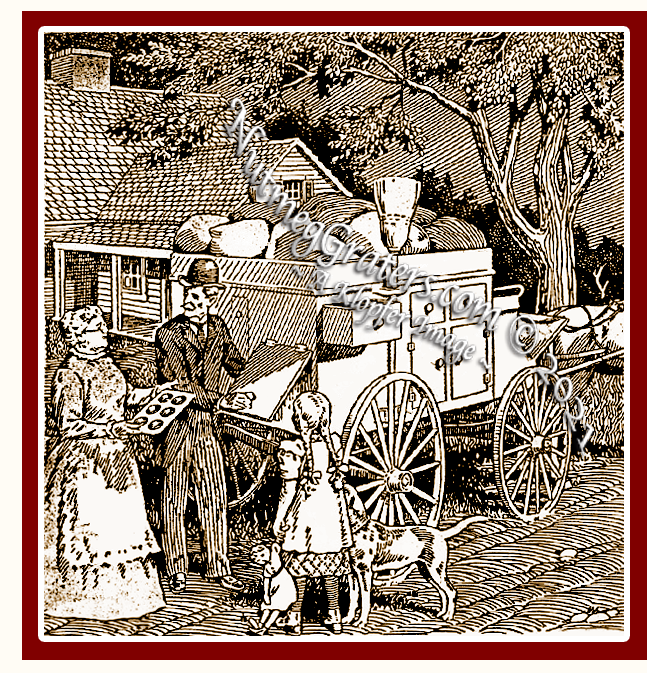 Julius was born in Southington, the son of Joel Neal (1799~1835) and Harriet {Woodruff} (1800~1849); he was the nephew to Jeremiah Neale (1802~1890) and Charlott (1806~ ); and, his grandparents were Jeremiah Neal (1757~1827) and Anna {Fuller} (1760~1823). In Southington, Julius's father Joel died when he was only 10 years old and records indicate that Julius developed close ties to his Uncle Jeremiah Neale. At age 25 and still living in Southington, Julius lived next door to his uncle, being employed as a "bolt maker" at his uncle's "fabricated steel products" business. In 1848, Julius married Melissa R. and in 1850, their only child Joel S. was born. After Jeremiah Neale relocated to Plainville in the early 1850's, Julius soon followed. Based on local tax records, in their early years living in Plainville, Julius and Melissa rented their residence, but by the 1860's, Julius owned his own home on Main Street, three blocks from his uncle (See Maps: Fig G & H ~ Highlighted In Yellow-{above}). From the mid-1850's and well into the 1870's, Julius successfully worked as a Traveling Agent. This line of work requires someone to become a Jack-Of-All-Trades. Traveling Agents lived by establishing trust from their customers, as well as sustaining repeat trade routes. Some Traveling Agents developed business relationships in large cities, marketing products from up-scale hotels; others established annual trade routes throughout rural communities. Nothing specific is known about the exact nature of Julius's business, but for 20 years, he was successful. In this line of work, it would be typical for buying product "rights" and then marketing this product. Julius had many connections to manufacture and market a fancy tinware nutmeg grater, yet, this too is conjectured.
Julius was born in Southington, the son of Joel Neal (1799~1835) and Harriet {Woodruff} (1800~1849); he was the nephew to Jeremiah Neale (1802~1890) and Charlott (1806~ ); and, his grandparents were Jeremiah Neal (1757~1827) and Anna {Fuller} (1760~1823). In Southington, Julius's father Joel died when he was only 10 years old and records indicate that Julius developed close ties to his Uncle Jeremiah Neale. At age 25 and still living in Southington, Julius lived next door to his uncle, being employed as a "bolt maker" at his uncle's "fabricated steel products" business. In 1848, Julius married Melissa R. and in 1850, their only child Joel S. was born. After Jeremiah Neale relocated to Plainville in the early 1850's, Julius soon followed. Based on local tax records, in their early years living in Plainville, Julius and Melissa rented their residence, but by the 1860's, Julius owned his own home on Main Street, three blocks from his uncle (See Maps: Fig G & H ~ Highlighted In Yellow-{above}). From the mid-1850's and well into the 1870's, Julius successfully worked as a Traveling Agent. This line of work requires someone to become a Jack-Of-All-Trades. Traveling Agents lived by establishing trust from their customers, as well as sustaining repeat trade routes. Some Traveling Agents developed business relationships in large cities, marketing products from up-scale hotels; others established annual trade routes throughout rural communities. Nothing specific is known about the exact nature of Julius's business, but for 20 years, he was successful. In this line of work, it would be typical for buying product "rights" and then marketing this product. Julius had many connections to manufacture and market a fancy tinware nutmeg grater, yet, this too is conjectured.
By the mid-1870's, Melissa and Julius mysteriously disappear from all records (including from any later U.S. Census). In 1880, their son Joel S. is boarding in Southington with his elderly Aunt Susan Woodruff. Joel S. is 31 years old, working at local coffee mills.
In Conclusion:
We may never know with certainty, which of the four Neals is the one who's name J. Neal appears on this nutmeg grater. Regardless, it seems that the nutmeg grater was produced for a very short time and never received a patent. As with many mechanical nutmeg graters, each is a product of their time. When they are no longer a viable product, their inventors move towards other ventures. Plainville's strong financial investment interests of the 1850's declined following the Civil War, and by the 1880's, only two Neal families remained in Plainville ~ Jeremiah was one of them, being in his 80's and retired.
What is "PATENT APPLIED FOR":
In the United States, "patent applied for", or "patent pending" are terms lawfully applied to inventions during the time period when a formal patent application is submitted and remains under consideration. If the patent application is rejected and is no longer under consideration, it becomes illegal to apply these terms to that product. Later in the century, many manufacturers illegally applied these labels on products that were never in the process to be patented, to fend-off others from counterfeiting their product. At the time of the J. Neal product, the United States Patent Office require both a patent application and a patent model to be submitted; both which were maintained by the Patent Office, even for those applications that never received patents. In the 20th century, the storage of all this became overwhelmingly. All "failed" patent applications were discarded and the patent models sold as "junk". [In the 1970's, it was said that most of the patent models were acquired by the New York State auctioneer, O. Rundle Gilbert (Garrison, NY), who periodically sold them to the public.] Could there be a J. Neal patent model ? It is anyone's guess.
By Theodarus Lambertus Uriot.
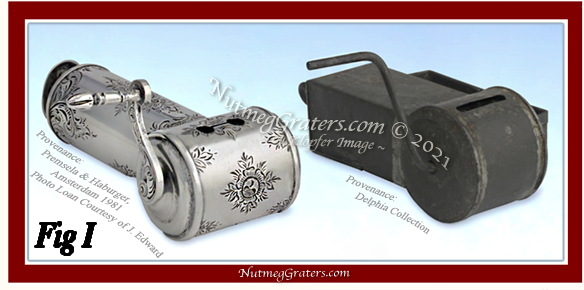 How this design transferred across the Atlantic Ocean to Amsterdam remains a mystery, but the evidence speaks for itself. A simple side by side photograph illustrates (Fig I) 3 that the silver mechanical nutmeg grater (on the left) is a refined, up-scale version copied from the J. Neal nutmeg grater (on the right). Being manufactured using different metals, both examples are identical in scale, form and design. Each is constructed with a rotating cylinder-grate turned by a crank handle. Each presses a nutmeg under spring tension against its rotating cylindrical grating surface. Each has a plunger handle bearing a "stopper-collar" to restrict the plunger from pressing down against its grating-cylinder's rough surface (See: Fig J).3 Also matching is the aperture location, the opening from which the grated nutmeg is sprinkled. While the tin one is utilitarian, the silver example is fashionably elegant.
How this design transferred across the Atlantic Ocean to Amsterdam remains a mystery, but the evidence speaks for itself. A simple side by side photograph illustrates (Fig I) 3 that the silver mechanical nutmeg grater (on the left) is a refined, up-scale version copied from the J. Neal nutmeg grater (on the right). Being manufactured using different metals, both examples are identical in scale, form and design. Each is constructed with a rotating cylinder-grate turned by a crank handle. Each presses a nutmeg under spring tension against its rotating cylindrical grating surface. Each has a plunger handle bearing a "stopper-collar" to restrict the plunger from pressing down against its grating-cylinder's rough surface (See: Fig J).3 Also matching is the aperture location, the opening from which the grated nutmeg is sprinkled. While the tin one is utilitarian, the silver example is fashionably elegant.
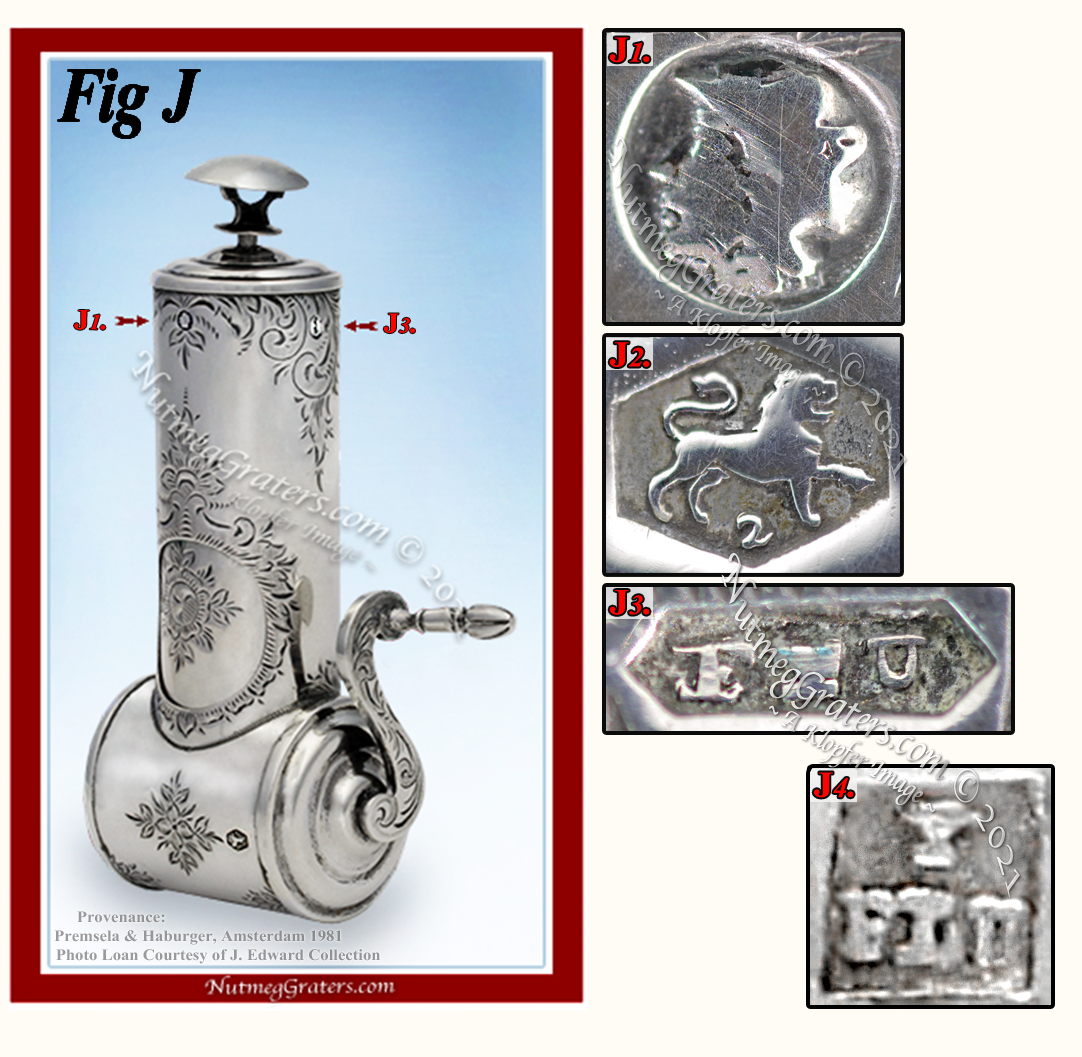
Silver mechanical nutmeg graters are very rare, with only a handful being known. Made well, this Dutch example is particularly beautiful.
Dutch silver is often "hallmarked". This mechanical silver nutmeg grater has three marks: J1.) an inspection office mark; J2.) a silver fineness mark; and, J3.) a maker's mark. Apparently, a "date mark" is absent.
The Inspection Mark (J1):
An early-form Duty Mark of the "Minervakop ter Herkenning Van Het Keurkantoor " (Minerva Head to Recognize The Inspection Office) incorporates the letter 'A' on the back of its head, indicating certified inspection by the Office in Amsterdam. The "(J1) arrow" in (Fig J) points to the Minerva mark's location which was carefully placed, concealing it within the decoratively engraved scrolling.
The Silver Fineness Mark ( J2):
A "Lion passant '2' " is a Grade Mark to indicate the silver fineness of 833/1000 or 83.3% pure silver. This specific mark was used for a duration ranging from January 14, 1814 to September 1, 1953. It is clearly visible on the front of the nutmeg grater "(Fig J) lower right".
The Maker's Mark (J3):
A very tiny intaglio lozenge-shaped Maker's Mark (measuring only 2.83 mm long by .7mm wide) is well disguised
within the scrolled engraving. Inside the main image (Fig J), the "(J3) arrow" shows the mark's location. (NOTE: The mark's location is further highlighted within white.) A lozenge shaped maker's mark is commonly found on silver from both The Netherlands and France. This maker's mark is so small, it could not be clearly seen using a jeweler's loop nor when photographed using a standard close-up lens; instead requiring a specialized Canon MP-E 65mm close-up lens to capture a clean image. This is one of several maker's mark representing the Uriot silversmiths.
The Mark Of Theodarus Lambertus Uriot:
Between 1812 and 1909, there were three generations of Uriots working in silver, gold and jewelry finery [The Father: Petrus Ludovicus Uriot-I (1785~1864) {working in Amsterdam 1812~1862); The Son: Theodore Lambertus Uriot (1817~1891) {working in Amsterdam 1847~1891}; and The Grandson: Pierre Louis Uriot-II (1848 ~ ) {working in Amsterdam 1878 ~ 1909}]. The Uriot family are described as "small workers", meaning that they manufactured small items primarily in silver and some in gold. Most of their work was cutlery, many items being intricate and unusual utensils (serving sets, fish slicers, asparagus tongs, egg spoons, fruit scoops, etc.). They also made elegant sewing equipment, small silver baskets, coin boxes, grape shears, spectacle cases, and more. Some published accounts indicate Petrus Uriot-I was a merchant who retailed his own work as well as that of other silversmiths. Pierre L. Uriot-II focused on making jewelry in addition to products in silver and gold.
The large square intaglio maker's mark (J4) is the well established mark for "Theodorus Lambertus Uriot" when he worked independently (between 1858 and 1878). This mark is frequently seen on the back handles of his silver cutlery. The tiny intaglio lozenge-shaped maker's mark (J3) found on this Dutch mechanical nutmeg grater is less well known. Although these marks differ in size and shape, the letter styling is identical, with the tiny lozenge-shape mark being an appropriate scaled size for this nutmeg grater. The similar "font-styling" (J3 & J4) identifies these both as Theodorus Lambertus Uriot's work. Petrus L. Uriot-I also had his own large square and small lozenge shaped maker's marks. Because the nutmeg grater lacks the "date-mark", based on its decorative styling and the period following production of the "J. Neal" nutmeg grater, T. L. Uriot's nutmeg grater was probably made between Circa 1858 to 1865. The Table (below) provides a time-line overview of data regarding the three Uriot generations.ºº The data (below) was condensed from various sources from which data contradictions were present; NutmegGraters.Com included information which appeared most accurate. Further study is need for full verification.
For today's collectors, the J. Neal Nutmeg Graters are very scarce and the Uriot Nutmeg grater is probably unique.
| Petrus Ludovicus URIOT - I | Theodore Lambertus URIOT | Pierre Louis URIOT - II | T.L.Uriot en Zoon (& Son) |
|---|---|---|---|
OCCUPATION:merchant-silversmith |
OCCUPATION: gold, silver, jeweler |
OCCUPATION: goldsmith, jeweler |
BUSINESS: Jewelry, Silver & Gold |
VITAL STATISTICS: 2 |
VITAL STATISTICS: 2 |
VITAL STATISTICS: 2 |
LOCATION: Amsterdam |
BIOGRAPHICAL STATISTICS: |
BIOGRAPHICAL STATISTICS: |
BIOGRAPHICAL STATISTICS: |
|
WORK STATISTICS:2 |
WORK STATISTICS:2 |
WORK STATISTICS: 2 |
|
ADDED NOTES: 2 |
ADDED NOTES: 2 |
ADDED NOTES: 2 |
REFERENCES:
1 Castler, H. A. The History Of Plainville Connecticut 1640~1918, Globe Pequot Guilford, CT, 1972 (2018 Ed.), ISBN: 978-1-4930-3328-7.
2 RKD ~ Nederlands Instituut voor Kunstgeschiedenis, "Theodorus Lambertus Uriot", The Hague, The Netherlands. [Partial Materials Only]
[RKD = Rijksbureau voor Kunsthistorische Documentatie]
3 Klopfer Photographs From Loan Collections : Thank you ~ J. Delphia; and, J. Edward Collection
Help us find photographs of the Neal families, their homes or businesses. We would love to include these images with this research.
Is anyone wishing to share their images? Let us hear from you. Thanks you!
[KLOPFER article © September 2021]
